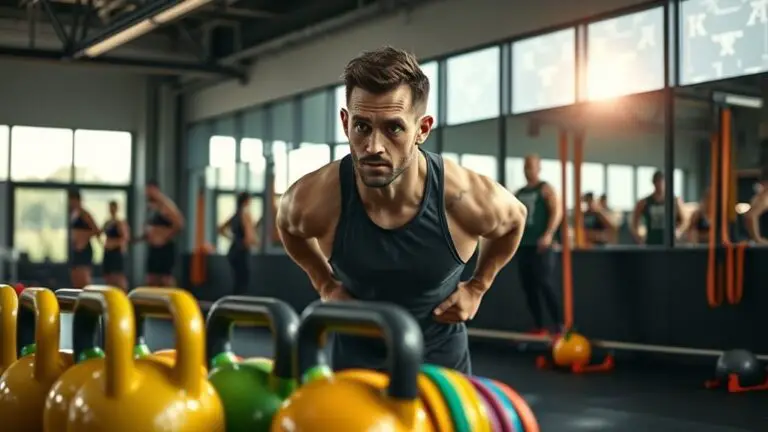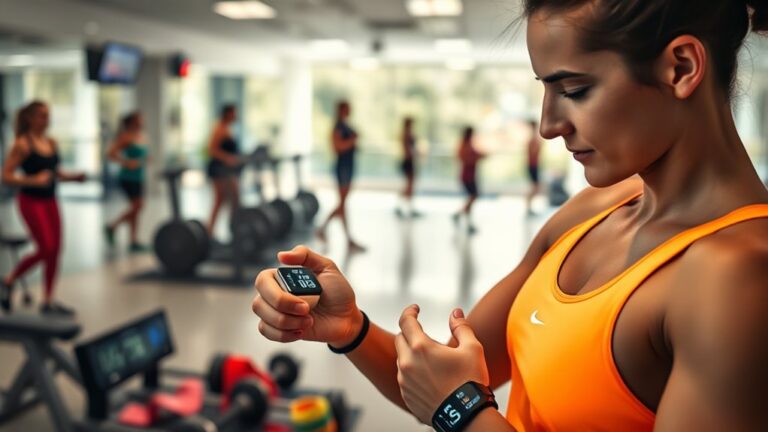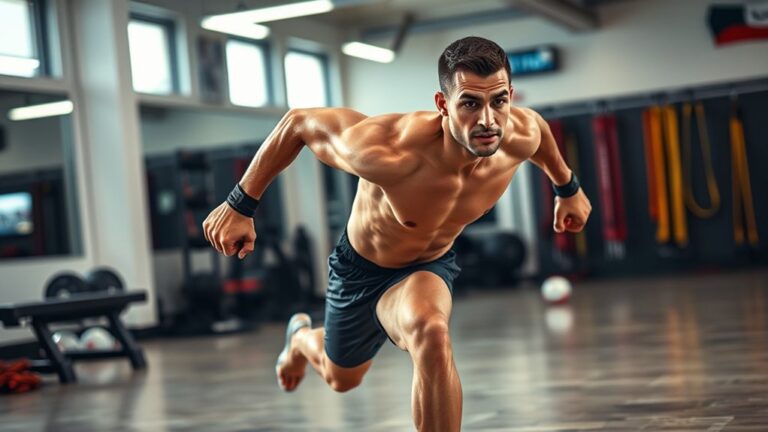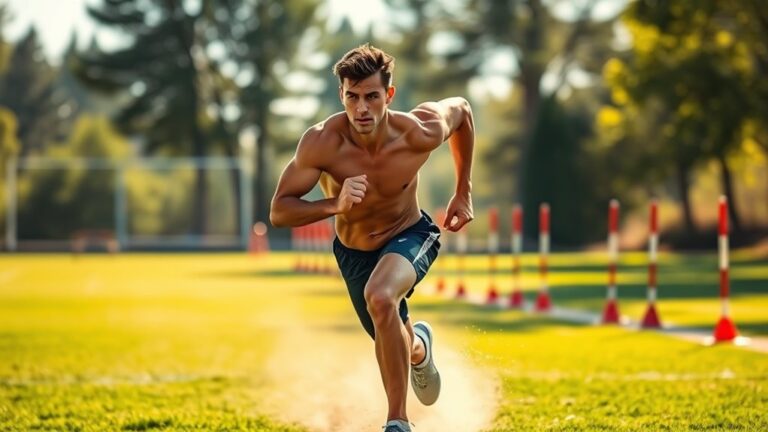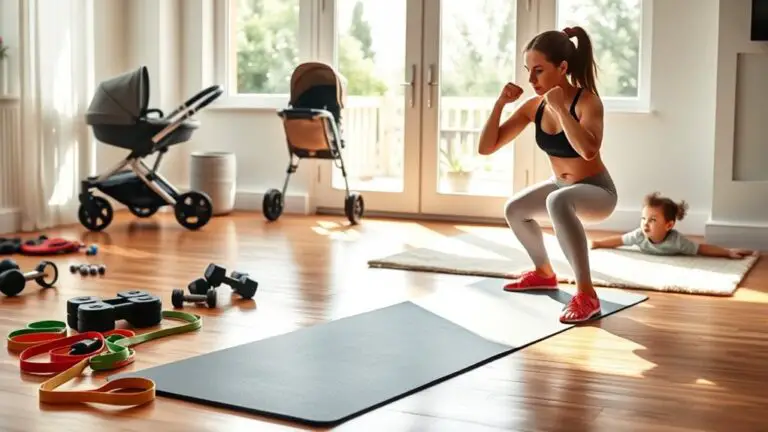How to Train for Lateral Speed and Agility
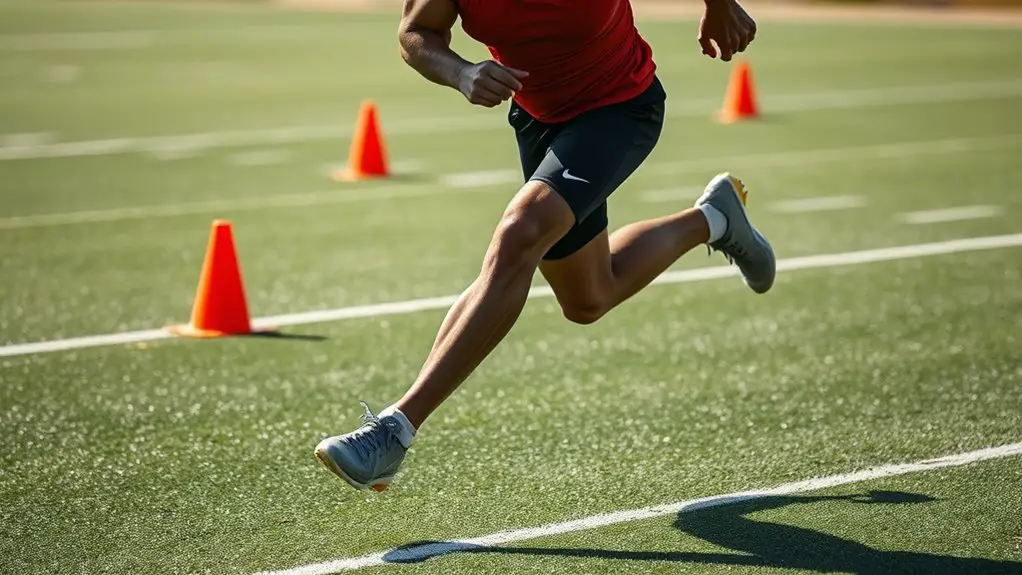
To train for lateral speed and agility, focus on specific drills like ladder and cone exercises that enhance footwork and coordination. Incorporate plyometric movements such as lateral bounds and box jumps to boost explosive power. Don’t underestimate warm-ups; dynamic stretches and hip mobility exercises are essential for injury prevention. Measure your progress with shuttle tests and adjust your routine based on performance. Keep pushing your limits, and you’ll discover even more effective strategies to elevate your game.
Understanding Lateral Speed and Agility
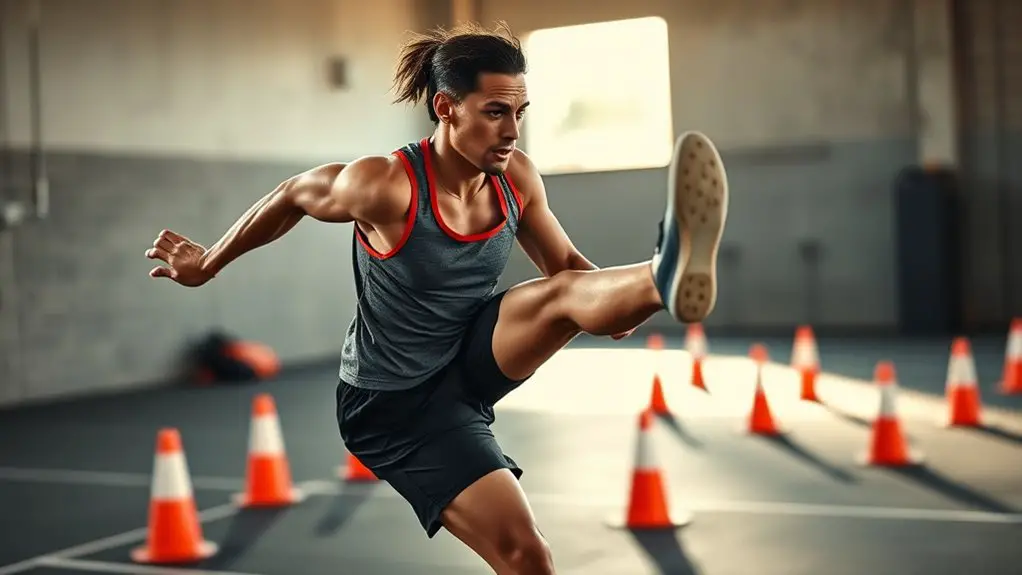
Lateral speed and agility are essential components of athletic performance, particularly in sports that require quick changes in direction. To excel, you need a solid grasp of lateral movement mechanics. This involves understanding how your body shifts weight, engages your core, and utilizes your lower body effectively. Mastering these mechanics can greatly enhance your agility performance factors, which include reaction time, balance, and coordination.
When you focus on improving these elements, you’ll notice a marked difference in your ability to respond to sudden changes in play. Incorporating drills that emphasize lateral movement will help you develop the strength and flexibility necessary for explosive side-to-side actions. Remember, it’s not just about speed; it’s also about the precision of your movements. Commit to refining your technique, and you’ll find that improving your lateral speed and agility can elevate your overall athletic performance.
Benefits of Lateral Movement Training
While many athletes focus on linear speed, the benefits of lateral movement training can’t be overlooked. Incorporating lateral movements into your routine greatly enhances your overall performance. Here are four key lateral movement benefits that you shouldn’t ignore:
- Improved Agility: Mastering side-to-side movements sharpens your ability to change direction quickly.
- Enhanced Stability: Training laterally strengthens your core and lower body, leading to better balance and coordination.
- Injury Prevention: By developing the muscles used in lateral movements, you reduce the risk of strains and sprains.
- Sport-Specific Advantages: Many sports require quick lateral shifts; this training gives you a competitive edge.
Key Muscle Groups Involved in Lateral Movement
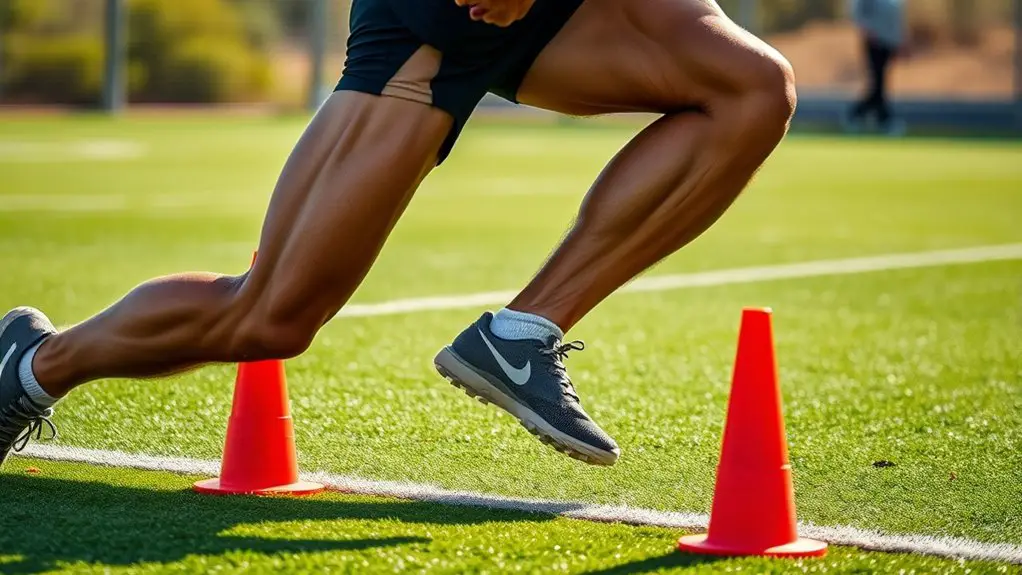
To excel in lateral movement, you need to understand the key muscle groups that drive your agility. The primary muscles, along with stabilizing ones, play a vital role in maintaining balance and power during those quick side-to-side motions. Additionally, flexibility and mobility are essential for optimizing your range of motion and preventing injury, so let’s break down how to effectively train these areas.
Primary Muscle Groups
When it comes to enhancing your lateral speed and agility, understanding the primary muscle groups involved is essential. Focusing on muscle activation and achieving strength balance is vital for peak performance. Here are the key muscle groups to target:
- Gluteus Medius: Critical for hip stabilization and lateral movement.
- Quadriceps: Provides power for explosive side steps and sprints.
- Hamstrings: Essential for deceleration and maintaining speed.
- Calves: Important for push-off and quick lateral shifts.
Stabilizing Muscles Importance
The role of stabilizing muscles in lateral movement can’t be overstated; they provide the foundation for effective agility and speed. When you engage in lateral drills, your stabilizing muscles, including the glutes, hip flexors, and core, work together to maintain balance and control. Strong core strength is essential here, as it helps transfer energy efficiently during quick directional changes. Weak stabilizing muscles can lead to instability, increasing the risk of injury and reducing your overall performance. By focusing on exercises that target these key muscle groups, you’ll enhance your ability to move explosively side-to-side. Prioritize strengthening your stabilizing muscles, and you’ll notice significant improvements in your lateral speed and agility, allowing you to outperform your competition.
Flexibility and Mobility
While many athletes focus on strength and speed, flexibility and mobility are equally essential for enhancing lateral movement. Improved joint mobility allows for quicker, more efficient shifts, reducing the risk of injury. To maximize your lateral agility, consider the following key muscle groups and techniques:
- Hip Flexors: Engage in dynamic stretching to increase range of motion.
- Adductors: Focus on flexibility to allow for smoother lateral shifts.
- Ankles: Enhance joint mobility for better stability and quick changes in direction.
- Core Muscles: Strengthen your core to maintain balance and control during lateral movements.
Incorporating these elements into your training will boost your overall performance and agility on the field.
Warm-Up Exercises for Lateral Agility
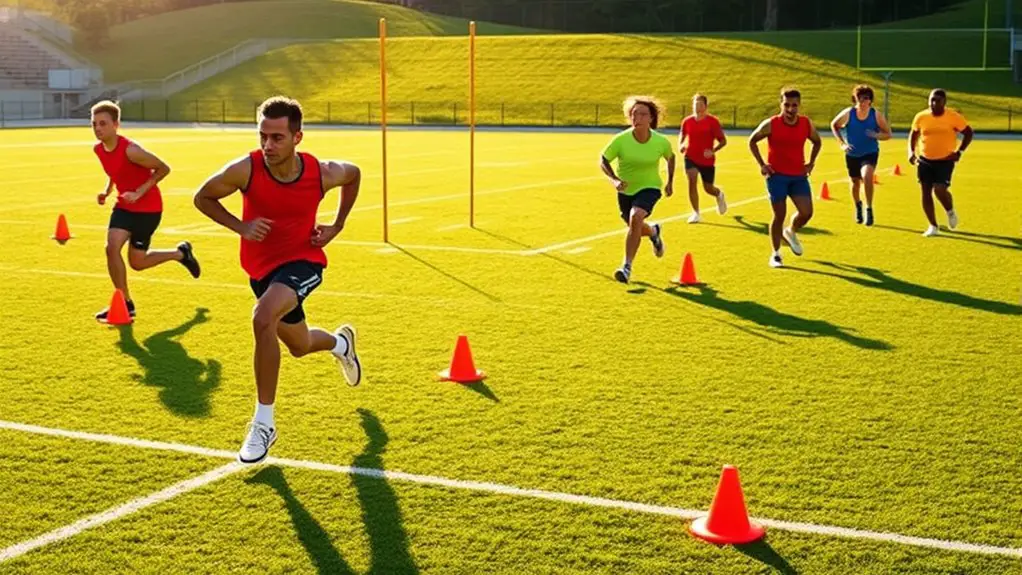
A proper warm-up is essential for enhancing your lateral agility, as it prepares your muscles and joints for the dynamic movements ahead. Start with dynamic stretching to increase blood flow and flexibility. Incorporate hip mobility exercises like leg swings and hip circles; these target the hip flexors and improve your range of motion, which is vital for lateral movements.
Next, include lateral lunges and side shuffles to activate the specific muscle groups you’ll rely on. This not only primes your body but also enhances coordination and balance. Don’t forget to engage your core, as a strong center stabilizes your movements.
Finally, perform agility drills at a low intensity, gradually increasing your speed. This progressive approach helps to solidify the connection between your mind and body, ensuring you’re ready to tackle more intense lateral challenges ahead. Prepare well, and you’ll see significant improvements in your agility performance.
Essential Drills to Improve Lateral Speed
To enhance your lateral speed, incorporating ladder and cone drills into your training regimen is essential. These exercises not only improve your footwork but also develop your agility and coordination, allowing you to change direction more efficiently. Let’s break down how each drill contributes to your overall performance on the field or court.
Ladder Drills
Ladder drills are among the most effective exercises for enhancing lateral speed and agility, providing a dynamic way to improve footwork and coordination. By incorporating various ladder variations, you can target different aspects of your agility training. Focus on proper foot placement during each drill to maximize effectiveness. Here are four essential ladder drills to try:
- In and Out: Step quickly in and out of each rung, emphasizing quick foot movement.
- Lateral Shuffle: Move sideways along the ladder, ensuring both feet hit each space.
- Single Leg Hops: Hop through the ladder on one foot to build balance and strength.
- Icky Shuffle: Alternate your foot placement in a three-step sequence for increased coordination.
Integrate these drills into your routine for peak results!
Cone Drills
Cone drills are essential for developing lateral speed and agility, as they simulate real-game scenarios where quick changes in direction are crucial. By strategically setting up cone placement, you can create various patterns that challenge your ability to pivot, accelerate, and decelerate efficiently. Consider incorporating drill variations like the box drill or T-drill to target different movement mechanics. These drills not only improve your footwork but also enhance your body control and reaction time. As you progress, focus on maintaining proper form while pushing your limits. Remember, consistency in practice will yield significant improvements in your lateral speed. So, get out there, set up those cones, and release your potential!
Incorporating Plyometrics for Enhanced Agility
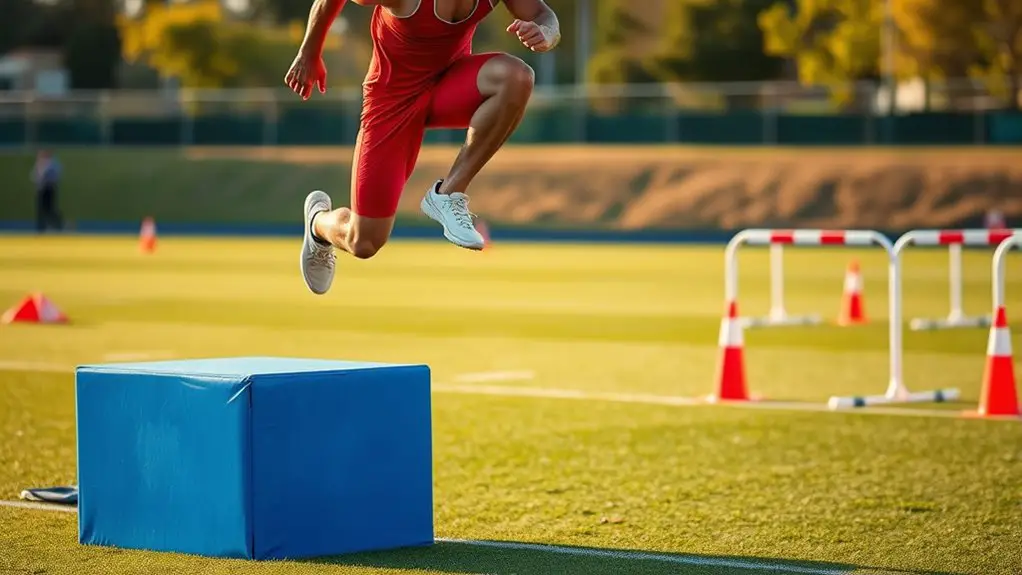
While many athletes focus on traditional strength training to improve their performance, incorporating plyometrics can greatly enhance your lateral speed and agility. Plyometric exercises, which include jump training, help develop explosive power and quickness, essential for rapid lateral movements. Here are four effective plyometric exercises to include in your routine:
- Lateral Bounds: Jump side-to-side, emphasizing distance and control.
- Box Jumps: Jump onto a sturdy box, focusing on landing softly and maintaining balance.
- Single-Leg Hops: Perform hops on one leg to improve stability and strength.
- Depth Jumps: Step off a box and jump immediately upon landing, training your reactive strength.
Tips for Measuring Progress in Lateral Speed
To effectively gauge your progress in lateral speed, it’s crucial to implement specific metrics that can provide clear insights into your performance. Regular progress tracking not only keeps you accountable but also helps identify areas for improvement. Here are some key performance metrics to examine:
| Metric | Description | Frequency |
|---|---|---|
| 5-10-5 Shuttle Test | Measures quick lateral movement | Bi-weekly |
| Lateral Cone Drills | Evaluates agility and speed | Weekly |
| Reaction Time Tests | Assesses quickness in response | Monthly |
| Video Analysis | Provides visual feedback | After major sessions |
Using these metrics, you can analyze data trends and adapt your training regimen accordingly. Remember, consistent measurement fosters motivation and drives performance improvements. Stay dedicated, and you’ll see the results in your lateral speed!
Injury Prevention Strategies for Lateral Training
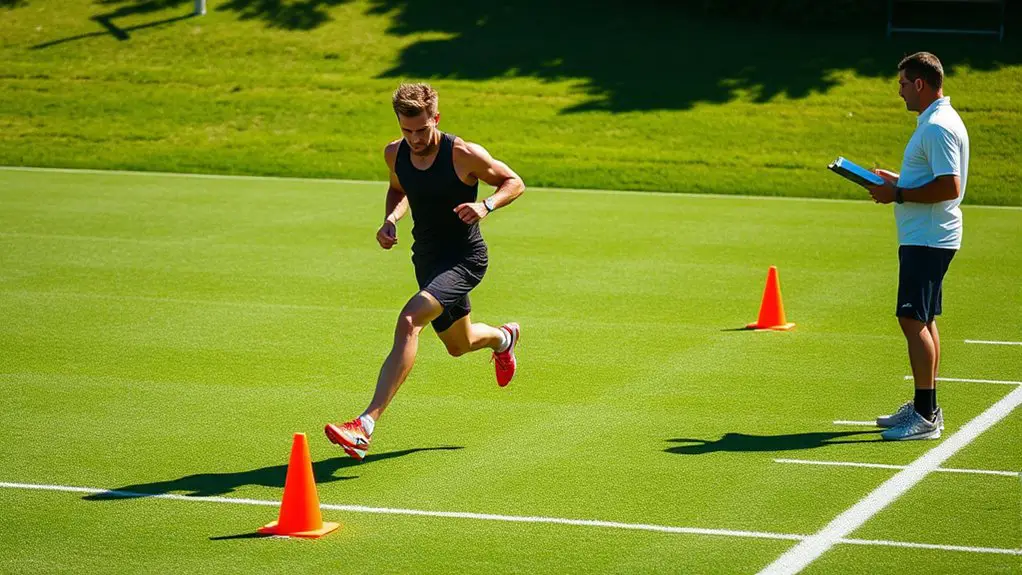
As you track your progress in lateral speed, it’s equally important to focus on injury prevention strategies that support your training. Incorporating these strategies will help you stay healthy and maximize your performance:
- Dynamic Warm-ups: Engage in movements that mimic lateral drills, increasing blood flow and flexibility.
- Strength Training: Focus on your lower body, core, and stabilizing muscles to enhance resilience against injuries.
- Proper Footwear: Invest in shoes that provide adequate support and traction for lateral movements, reducing the risk of ankle injuries.
- Recovery Techniques: Implement foam rolling, stretching, and adequate rest to promote muscle recovery and prevent overuse injuries.
Frequently Asked Questions
How Often Should I Train for Lateral Speed and Agility?
When considering your training frequency for lateral speed and agility, aim for 2 to 3 sessions per week. This allows you to build strength and coordination effectively without risking burnout. Be sure to incorporate adequate recovery periods between sessions—rest is essential for muscle repair and performance enhancement. By balancing consistent training with proper recovery, you’ll maximize your gains and maintain motivation, ultimately improving your overall athleticism and responsiveness on the field.
What Age Is Appropriate to Start Lateral Movement Training?
“You’re never too young to start moving.” It’s essential to contemplate developmental stages when introducing lateral movement training. Most coaches recommend beginning as early as age 7 or 8, as this is when children can effectively grasp basic training methods. At this age, focus on fun, engaging drills that enhance coordination and balance. As they grow, you can gradually incorporate more complex techniques to improve their speed and agility for future athletic success.
Can Lateral Agility Training Help in Team Sports?
Absolutely, lateral agility training can greatly enhance your team sports performance. By focusing on lateral movement benefits, you’ll improve your quickness, balance, and overall coordination. This not only allows you to evade opponents more effectively but also enhances your ability to change direction swiftly during gameplay. As you develop these skills, you’ll notice a marked improvement in your reaction times and decision-making, leading to greater contributions on the field or court.
What Equipment Do I Need for Lateral Speed Training?
For effective lateral speed training, you’ll need some essential equipment. Training cones are vital for setting up lateral drills, allowing you to focus on quick changes in direction. Consider agility ladders for footwork precision and resistance bands to enhance your strength. Additionally, a stopwatch can help track your progress. By consistently incorporating these tools into your routine, you’ll boost your lateral speed and agility, making you a more formidable athlete on the field.
How Long Before I See Improvements in My Lateral Speed?
You might think you’ll see lightning-fast improvements overnight, but that’s not usually how it works! With consistent training, you can expect to notice progress tracking in your lateral speed within a few weeks. The key is training consistency; commit to your regimen, and you’ll start feeling the difference. In about four to six weeks, you should be able to measure those gains, leaving you feeling unstoppable on the field. Keep pushing!
